Hominid Species Time Line
Page 32
Homo sapiens sapiens: The Symbol User
|
|
Based on current evidence, it appears that our species arose in Africa some time after 200,000 years ago. After spreading over that continent, the new species expanded out of Africa. There may have been two separate “radiations,” the first, some time after 100,000 years ago, followed the east coast of Africa and the south end of the Arabian peninsula and thence into South Asia, South East Asia, and Indonesia, and ending in Australia. Homo sapiens have been found in Australia dating to 40,000 or even 50,000 years old. A later radiation seems to have followed the route outward through the Sinai peninsula into the middle east and thereafter into Asia and Europe. They were in Europe by 40,000 to 35,000 years ago. The Americas were colonized by Homo sapiens some time after 20,000 years ago.
Skull size, tools, and distinctive features
The 130,000 year-old reconstructed skull shown below at left represents one of the earliest known example of a modern human being, Homo sapiens sapiens. It was found at Omo in East Africa; skull size and shape are completely modern. Shown beside the skull are some characteristic tools of Homo sapiens, all from East or South Africa: a bola for throwing at small game, flake tools, and a long flake blade and the core from which such blades have been struck.

Above center is a skull of "Cro-Magnon man" from Les Eysie, France, approximately 28,000 years old. The distinctive features of our species can be seen in the skull at far right, also an example of Cro-Magnon man, contrasted with a typical Neanderthal skull to its immediate left. The H. sapiens sapiens skull is smaller and more compact and the face is much less elongated than the Neanderthal; the modern human skull has a higher forehead, less prominent brow-ridges and smaller teeth. Modern humans are typically much less robust in body form and skeleton than Neanderthals.
Modern human females are only slightly smaller on average than males, but sexual dimorphism appears in many subtle ways.
Evidence of a hunting culture

These artists' reconstructions depict the rugged hunting life of the ice-age Europeans of our species [often called Cro-Magnon after an early discovery site in France]. These early Europeans were able to adapt to the severe conditions of the ice age and compete with the largest carnivores for the most formidable prey animals of Eurasia. With the aid of their advanced cultural and technological resources, they were able to adapt to severe conditions. Hunters living near the ice, like those depicted above right, followed the vast caribou or reindeer herds; hunters in Central and Eastern Europe lived a dangerous life hunting the Mammoth.
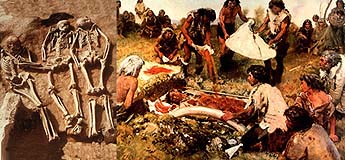 Homo sapiens sites present overwhelming evidence of pervasive cultural practices. The multiple burials from central Europe on the near right is 26,000 years old. The individual in the center of the burial had spinal scoliosis, an asymmetrical skull, and an under-developed right leg. The male on the left has a stake driven into his hip; a larger male on the far right lies face down. The male skulls were adorned with circles of arctic fox and wolf teeth and ivory bands.
Homo sapiens sites present overwhelming evidence of pervasive cultural practices. The multiple burials from central Europe on the near right is 26,000 years old. The individual in the center of the burial had spinal scoliosis, an asymmetrical skull, and an under-developed right leg. The male on the left has a stake driven into his hip; a larger male on the far right lies face down. The male skulls were adorned with circles of arctic fox and wolf teeth and ivory bands.
The painting at far right reconstructs the burial of a mammoth hunter found at Predmosti in central Europe. Red ochre is being scattered over the grave, which will be covered with a mammoth's shoulder blade and tusks.
Elaborate tools
|
|
The earliest artifacts of Homo sapiens are undistinguishable from Neanderthal (Mousterian) tools. Soon thereafter, however, they evolve into far more sophisticated forms than any which preceded them, and henceforth the tool kit shows a tendency to change fairly rapidly over time. Above, an artist has imagined how this increasingly complex cultural information was passed on to subsequent generations: hunters prepare stone tools as a young boy looks on, acquiring the technology of his people.
The bone needles on the right are evidence of sewn clothing. 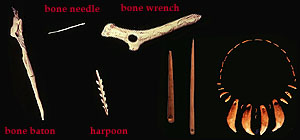 The elaborately carved bone batons (left and center) found all over Europe are somewhat of a mystery whose function is not clear; these strange cultural objects are usually fashioned from reindeer antler and elaborately decorated. They may have been insignia of command, like a mace or an officer's baton – hence the name.
The elaborately carved bone batons (left and center) found all over Europe are somewhat of a mystery whose function is not clear; these strange cultural objects are usually fashioned from reindeer antler and elaborately decorated. They may have been insignia of command, like a mace or an officer's baton – hence the name.
The necklace at far right contains the claws and teeth of cave bear and the teeth of a lion. Human beings are probably unique in their response to predators – the animals which prey upon them: humans actively seek out and attack feared predators and attempt to magically appropriate their powers by consuming their flesh or adorning themselves with symbols of their strength.
Cave art
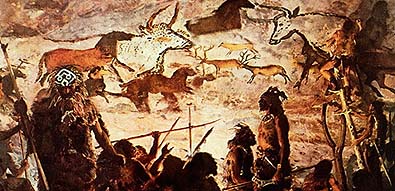
Dozens of cave sites have been found in Europe with remarkable paintings and other art work dating from the period of intense cold, 25,000-14,000 years ago. The paintings at Lascaux are hundreds of feet underground and remote from living areas of the cave complex. It is assumed that such cave art had a religious or cultic function. In this reconstruction of the uses of Lascaux, the most famous of these "prehistoric cathedrals," the artist has depicted an initiation of the young males of the tribe. The figure facing the viewer is presumably a shaman. The use or uses and the meanings of the paintings and the reasons for their placement underground in such caverns are, of course, hypothetical.
|
|
|
Distribution and design of cave art
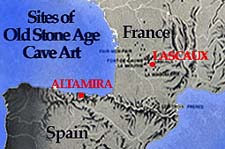 The distribution of sites of cave paintings in Western Europe demonstrates that caves and cave art were being used for a variety of ritual and social purposes by early human beings over a wide area in Europe from 25,000 to 14,000 years ago, at the height of the last glacial advance. Cave sites are still being discovered in Europe. Cave art is found usually deep underground, far removed from the living areas of the caves, which helps account for their preservation. A few carved stone reliefs have been found outside of caves. While the meaning – or meanings – of the cave images eludes us, their very remoteness and inaccessibility implies their serious and probably sacred functions. The image at top right shows the main gallery of the cave at Lascaux, France, perhaps the most famous of these sites. The image at right shows some of the detail of a rendering of a bull of the species of wild cattle (aurochs) often hunted by ice-age Europeans. Note that some images have been painted over, suggesting successive use of the cave walls over a period of time.
The distribution of sites of cave paintings in Western Europe demonstrates that caves and cave art were being used for a variety of ritual and social purposes by early human beings over a wide area in Europe from 25,000 to 14,000 years ago, at the height of the last glacial advance. Cave sites are still being discovered in Europe. Cave art is found usually deep underground, far removed from the living areas of the caves, which helps account for their preservation. A few carved stone reliefs have been found outside of caves. While the meaning – or meanings – of the cave images eludes us, their very remoteness and inaccessibility implies their serious and probably sacred functions. The image at top right shows the main gallery of the cave at Lascaux, France, perhaps the most famous of these sites. The image at right shows some of the detail of a rendering of a bull of the species of wild cattle (aurochs) often hunted by ice-age Europeans. Note that some images have been painted over, suggesting successive use of the cave walls over a period of time.

These images of (Przewalski's) horse, wild aurochs, and ibex from Lascaux, discovered in 1940, are rendered with such competence and flair that their authenticity – and their astonishing antiquity of 15,000 to 17,000 years – was at first questioned. Note the missile or slash marks near the horse and the spear or arrow near the cow's chest. Such features suggest that these images were used in a ritual or magical enactment of the hunt. Note the rectangular figure near the ibex, which has been interpreted as a trap by some, or an abstract pictograph (symbol) by others.
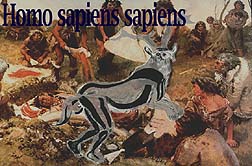
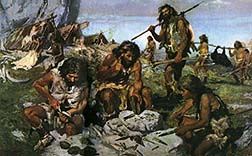
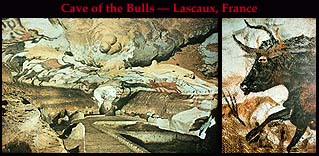

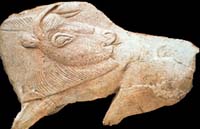 The European bison or wisent is one of the animals most commonly depicted in Paleolithic art. These treatments in several media in sandstone, reindeer horn, clay, and limestone (from above, to directly right, respectively) illustrate the sophistication of Paleolithic art. Note the similar stylistic treatment of the mane and beard of the bull at right and top center, which show that specific artistic conventions were passed from generation to generation. On the floor of the cave, near the finely sculpted clay images at top right, the artist's footprints are still preserved.
The European bison or wisent is one of the animals most commonly depicted in Paleolithic art. These treatments in several media in sandstone, reindeer horn, clay, and limestone (from above, to directly right, respectively) illustrate the sophistication of Paleolithic art. Note the similar stylistic treatment of the mane and beard of the bull at right and top center, which show that specific artistic conventions were passed from generation to generation. On the floor of the cave, near the finely sculpted clay images at top right, the artist's footprints are still preserved.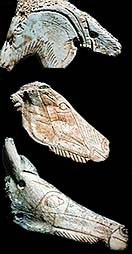
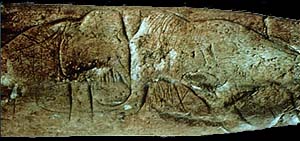
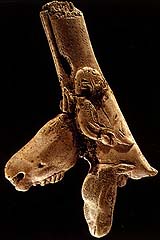 This baton or staff, found at Mas-d'Azil, France, is particularly intriguing and almost demands interpretation. This "baton" is of reindeer horn carved into the shapes of three horse heads – two live horses, either a mare and stallion or a colt and adult horse – and a flayed skull of a dead horse. Is this a depiction of the highly abstract idea of the cycle of life from juvenile stage to death? The carving demands to be "read" and interpreted.
This baton or staff, found at Mas-d'Azil, France, is particularly intriguing and almost demands interpretation. This "baton" is of reindeer horn carved into the shapes of three horse heads – two live horses, either a mare and stallion or a colt and adult horse – and a flayed skull of a dead horse. Is this a depiction of the highly abstract idea of the cycle of life from juvenile stage to death? The carving demands to be "read" and interpreted.
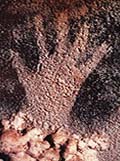 The image of the human hand at right, created by blowing paint from the mouth or a hollow tube on a cave wall at Pech-Merle, France, is like a signature nearly 20,000 years old. The 8 cm high carving of a human face on mammoth ivory (shown above from a number of different perspectives), is 26,000 years old. A number of human likenesses carved, like this one, on mammoth ivory, have been found in central Europe, in former Czechoslovakia. The object shown here is the oldest portrait of a human being yet discovered. The carver of this portrait, which shows exquisite details of the subject, including eyes, hair, mouth, and expression, was a master of his craft. The head appears to have been fastened to a staff or baton. The significance of such carvings is unknown.
The image of the human hand at right, created by blowing paint from the mouth or a hollow tube on a cave wall at Pech-Merle, France, is like a signature nearly 20,000 years old. The 8 cm high carving of a human face on mammoth ivory (shown above from a number of different perspectives), is 26,000 years old. A number of human likenesses carved, like this one, on mammoth ivory, have been found in central Europe, in former Czechoslovakia. The object shown here is the oldest portrait of a human being yet discovered. The carver of this portrait, which shows exquisite details of the subject, including eyes, hair, mouth, and expression, was a master of his craft. The head appears to have been fastened to a staff or baton. The significance of such carvings is unknown.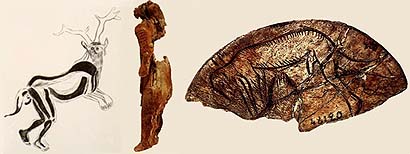
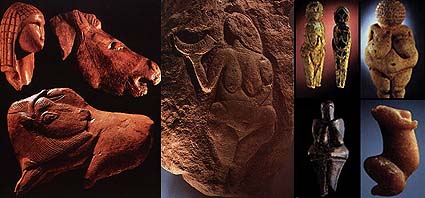
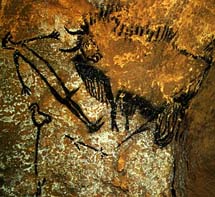 No example of early human art is more intriguing than this example from the deepest recesses of Lascaux. A wounded bison, its entrails spilling out, lowers its head to gore a male hunter, rendered as a crude stick-figure. A broken spear and a staff (or spear-thrower?) topped by a bird appear at bottom. The man appears to be wearing a bird-like mask or beak. Is the bird-on-the staff a symbol, an early pictograph representing a name?
No example of early human art is more intriguing than this example from the deepest recesses of Lascaux. A wounded bison, its entrails spilling out, lowers its head to gore a male hunter, rendered as a crude stick-figure. A broken spear and a staff (or spear-thrower?) topped by a bird appear at bottom. The man appears to be wearing a bird-like mask or beak. Is the bird-on-the staff a symbol, an early pictograph representing a name?